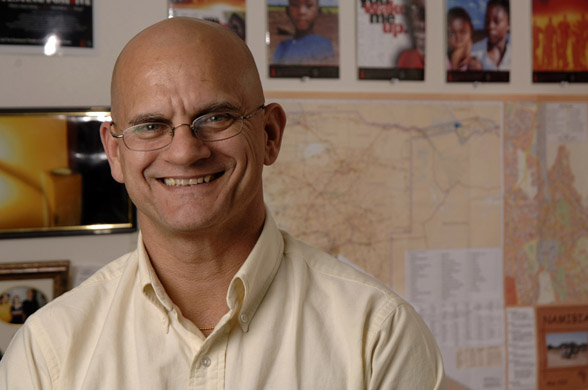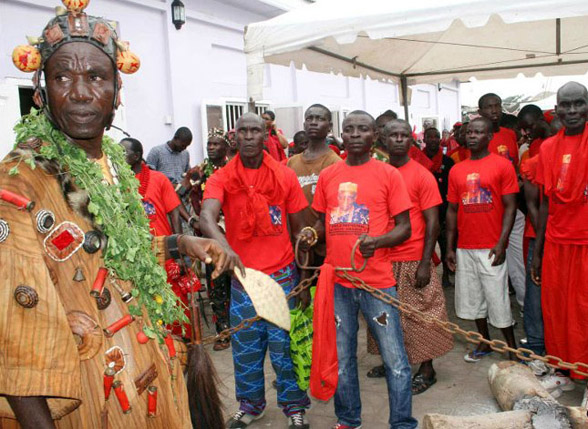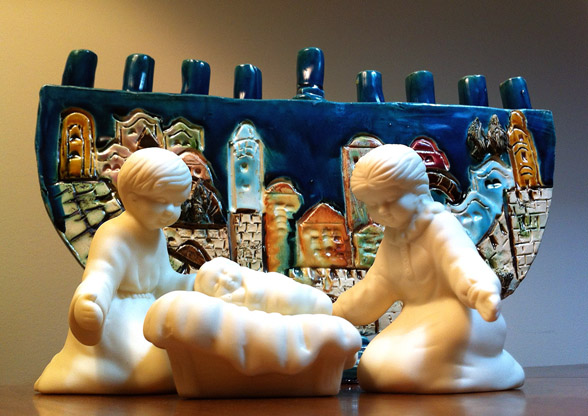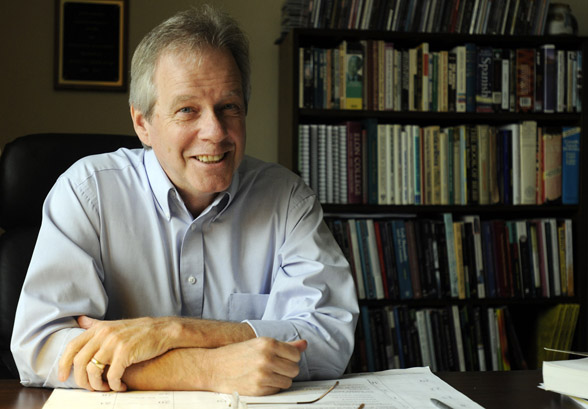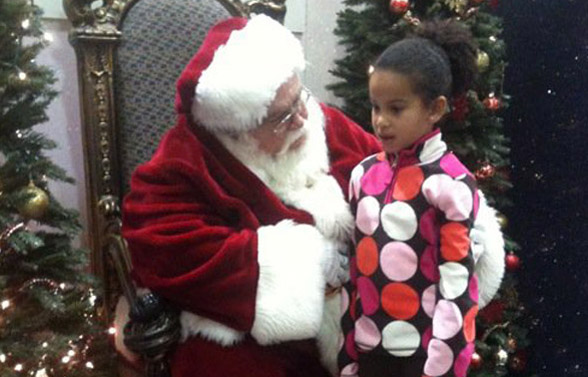What makes the holidays special? Is it the food, the atmosphere or the company? Whatever it is, one thing is certain: the holiday season means different things to different people.
*********
It’s not Christmas without lefse
Carolyn Nelson, director of design
|
|
Every Christmas, my grandma in Wisconsin made lefse — a soft, freckled Norwegian flatbread made from potatoes, flour and a little butter. She wrapped cooked batches in damp dishtowels to keep them from drying out, followed by layers and layers of wax paper and brown paper. She then tied them up with string and mailed them to her children as Christmas gifts.
When our package arrived in North Carolina a week or two later, my brother and I would stand at Daddy’s feet, wiggling with excitement as he painstakingly unwrapped each layer of paper. And as he did, he would describe how difficult it was for my grandmother to mash pounds of potatoes until there were no lumps, roll out perfect paper-thin circles that were so fragile that she had to roll them around a stick to transfer them to the griddle, and stand on her swollen feet by a hot wood stove for hours. At last, when he peeled away the last dishtowel, we would invariably find as many blue-green speckles of mold on the lefse as soft brown freckles. Undaunted, he would cut away the molded spots and we would celebrate as happily with slivers of lefse as we would have been with perfect rounds.
If I give you the impression that lefse tastes delicious, it does not. At best, it is a semi-flavorless wrap for cheese, meat or butter and sugar. But my father’s delight was infectious and his cherished Norwegian family tradition is mine. When Grandma’s health failed, Daddy and I both learned to make lefse. After he passed away, I became the only one in our family of Nelsons, Northern or Southern, who still makes it. I have a traditional grooved rolling pin and paddle from Wisconsin. And with an electric mixer and griddle, it isn’t as hard as it was for Grandma. Mostly, it just takes time and the ability to ignore flour dusting the kitchen. Most of my family doesn’t really care about it anymore and there are years when I think I might just skip it. But try as I might, I just cannot not make lefse at Christmas.
********
Oh, Christmas tree
Tom Arcaro, professor of sociology
|
|
Nowadays, Christmas can be seen as a cultural phenomenon – it’s about Black Friday, Christmas trees, family and presents. It has transcended religion; it is not uncommon for people from non-Christian faith (or non-faith) traditions to put up a Christmas tree because it’s a fun and colorful part of the culture.
In our home, putting up a Christmas tree is a huge deal. We have three children – an 11-year-old, Amelia, a 7-year-old, Eleanor, and a 3-year-old, Julian. We like to go to the Wagoner’s Farm in Gibsonville, N.C., and cut down our own tree. They have a tractor and wagon that can pull you around; it’s a fun couple of hours. We like to play hide-and-seek before picking a tree among the many huge trees they have at the farm.
We also like to play the Elf on the Shelf. The elf comes out right about now and will be somewhere in the house sitting on a shelf between now and Christmas (my 7-year-old was adamant that it showed up earlier). The idea is for the parents to move the elf overnight and the children to find it; they cannot touch it or move it during the day. It can be anywhere – on a shelf or hanging from something – and the last night you hide it is Christmas Eve. After that it’s gone until next year.
Santa is very much in the picture too. Eleanor is on the cusp, but she still believes in Santa and Julian is very excited with the idea, particularly because it involves presents.
********
When in Rome…
Jason Aryeh, assistant professor of performing arts
|
|
Growing up in Ghana, Christmas (or Thanksgiving for that matter) was not part of my culture, even though it is a national holiday there since a large majority of Ghanaians are Christian. For them, it’s mostly church activities. For me, it was a time to have fun with friends, invite people to eat, go to the city and have a good time. There was no tree or gifts. As a member of the Ga tribe, I celebrate important rites of passage – birth, puberty, marriage and death. Every tribe has its own festival that happens either twice or once a year; that is our Christmas in a way. For the Gas, there is a harvest festival called Homowo, which starts in May.
The festival, which takes two or three months of preparation, commemorates a period in our history when there was a serious famine in the land that forced us to migrate. We believe the gods gave us the food that put an end to the famine and this is our way to say ‘thanks’ to the gods for giving us abundance of food. There is music, dance and food as part of the festival. I’ll be in Ghana this summer so hopefully I’ll be able to celebrate it. For me, that’s my Christmas.
Since 2001, I’ve been to the United States several times and experienced Christmas with different families and it has been fun. I find myself buying gifts for friends even though it’s not part of my culture. As the saying goes, when in Rome, do as the Romans do. Though the holidays are different from country to country, it’s all about loving each other, or at least it has been in all the holidays that I’ve witnessed. If we continue to do that, it’d make living on earth a better place for all.
********
An interfaith celebration
Richard Landesberg, associate professor of communications
|
|
Our traditions started 10,000 miles and 2,000 years apart. We met in London, a good distance from my then home in Los Angeles and her home in Sydney, Australia. I grew up Jewish, the product of public schools in a New York City suburb. She grew up Catholic, attending the same Catholic school as her mother. When we met, Ginette was a medical doctor and I was years from getting my doctorate.
That first holiday season together I remember walking home along London’s Oxford Street. This main shopping area was decorated as if it were a Hollywood version of Christmas in Britain. When she got home, Ginette took the lift up to our flat, dragging along a little Charlie Brown Christmas tree that she hauled seven stops on the underground. The next spring, we went to Israel together, where we bought a Hanukah Menorah. After we married and moved to the United States, we finally worked out our cross-cultural traditions.
Every year, we trim our tree while listening to the soundtrack of “Fiddler on the Roof.” While Tevye sings about tradition, we hang ornaments that we have picked up in our travels or that Ginette’s family in Australia has sent us. At Hanukah, we light the Menorah, often with Jimmy Buffet’s Christmas album in the background. When I was in the broadcast journalism business I would work Christmas day so my Christian colleagues could have the time off. Ginette is traditionally on-call for her medical practice so others can be with their families. Christmas Eve is time for a good home-cooked meal. But Christmas night is time for a traditional Jewish, Christmas meal: carryout from our local Chinese restaurant. As Tevye says: “without tradition our lives would be as shaky as a fiddler on the roof.”
********
A Christmas Story
Jeffrey C. Pugh, professor of religious studies
|
|
The Christmas Eve service had not gotten off to a happy start. A little boy on the second row began projectile vomiting into the pew rack, onto the carpet and onto his clothes. I sent him next door to the parsonage to wash his clothes and lay down as I looked out upon the congregation with anxiety. My first Christmas Eve service as a student pastor of a United Methodist congregation in Stafford County, Va. had begun in ignominy. Things went from bad to worse when minutes after the service had begun I looked at the altar and realized we had no bread for Eucharist. I motioned to one of my daughters while we were singing the first hymn and had her scurry over to the parsonage to get the bread I had left on the kitchen counter.
I managed to get through the first hymn and opening prayers and went to light the advent wreath. As I held the candle over the wreath to light the Christ candle in the center I remember saying something eminently forgettable about light coming into the world, but what I recall most was the look on the congregation’s faces as they watched the black ashes from a now burning advent wreath floating above the head of their young minister. I turned to discover that I had set the advent wreath on fire. Don’t ever let anyone tell you evergreen doesn’t burn; it does, especially when there are pinecones involved. Fortunately we were able to put out the flame before the church burned down, though we did lose an altar cloth.
As I sat back down in my chair after the sermon, wondering who the new minister would be and where I would be moving in June, I heard a couple of women in the choir begin to sing. As I remember them the words were “Please Lord, help us in our hour of need,” but I am sure it was something more fitting to the season. As the song was picked up and carried through the crowd, an odd feeling swept over the community. I can’t to this day describe it, though when I told a Russian Orthodox friend about it he used the word, Sobornost, a feeling he described as the sense of community that overwhelms him when he is caught up in worship. When I tell the story I call it the Christmas spirit, but I know it was something more than that. It was certainly not anything that came manipulated by emotional appeal or coercion. For the Christian community, Christmas is a time that calls to our attention, “Immanuel,” God with us. So it is, even when everything else is going up in flames.
********
Home for the holidays
Sylvia Muñoz, director of El Centro
|
|
I usually go home to Costa Rica for Christmas. But since my husband cannot take time off to go with us, we have an early Christmas here every year. Our daughter, Daniela, writes a letter to Santa asking him to come early because she is going to Costa Rica. This year, Santa will come on the 19th or 20th. He will deliver the big presents but some of the little ones will make their way to Costa Rica so that she can open them there.
In Costa Rica, Christmas has more of a religious connotation; it is Baby Jesus who brings the gifts, not Santa. At around midnight on Christmas Eve, we put the baby in the nativity scene. Daniela knows both (American and Costa Rican) traditions, so she makes my mom buy carrots for the reindeer and cookies for Santa as well. Last year we left tres leches (a traditional Costa Rican cake) instead of chocolate chip cookies for Santa because Daniela thought Santa would like it better.
Christmas is my absolute favorite holiday. In Costa Rica, and especially in my family, we’re very close. We start making tamales four or five days prior to the celebration. On the 24th, we have 50 people over for dinner and then at 1 p.m. the next day, the same 50 people come over for lunch at my grandfather’s house. It’s really about being together. My husband is from Cuba so he never celebrated Christmas growing up. For him, it’s more of a commercial holiday. The day he celebrates it with us, he’s going to realize what he’s missing.



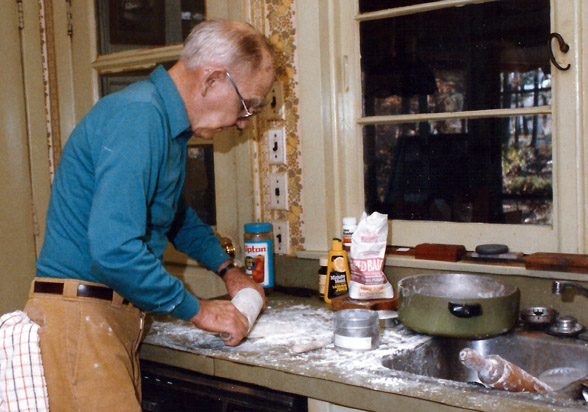 Carolyn’s father, Harold Nelson, making lefse
Carolyn’s father, Harold Nelson, making lefse